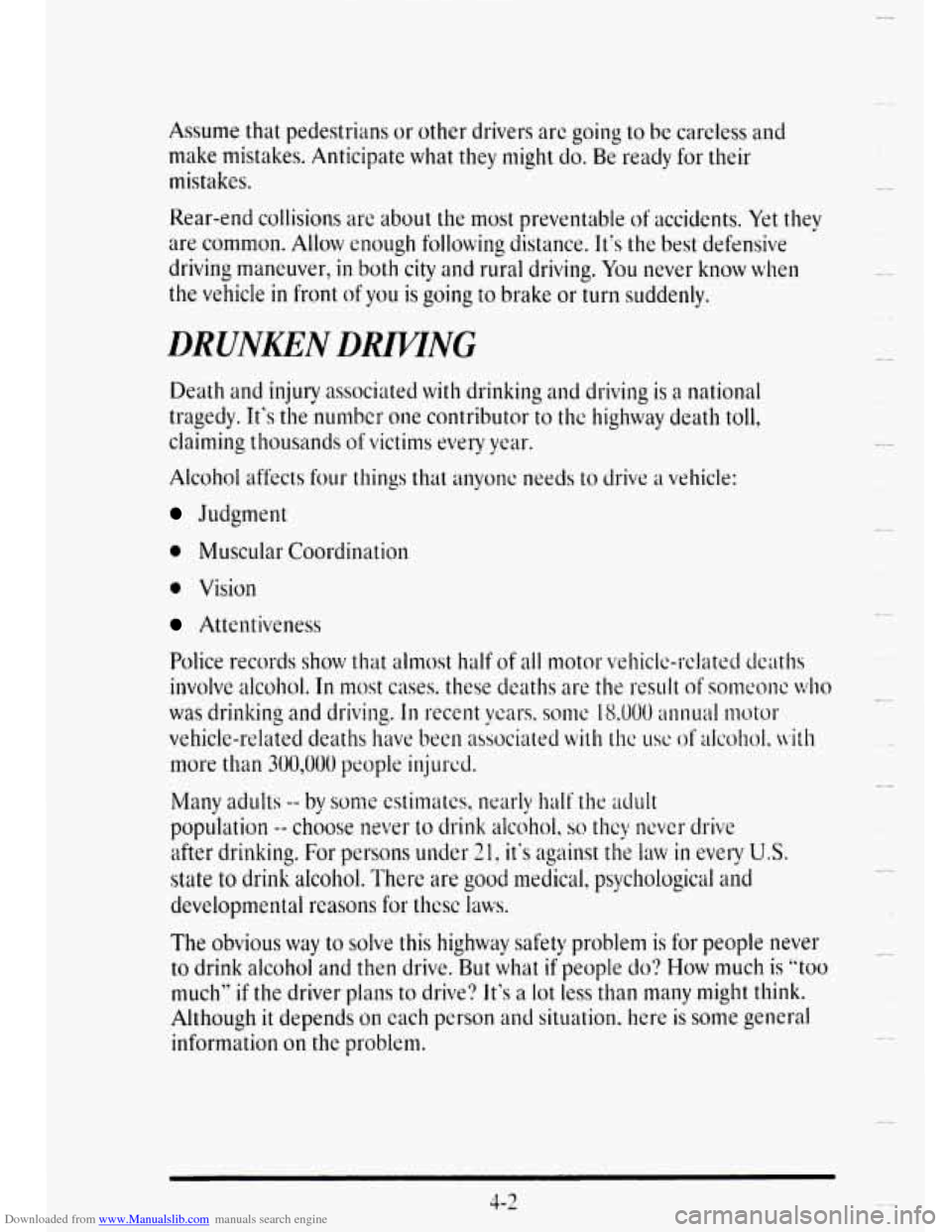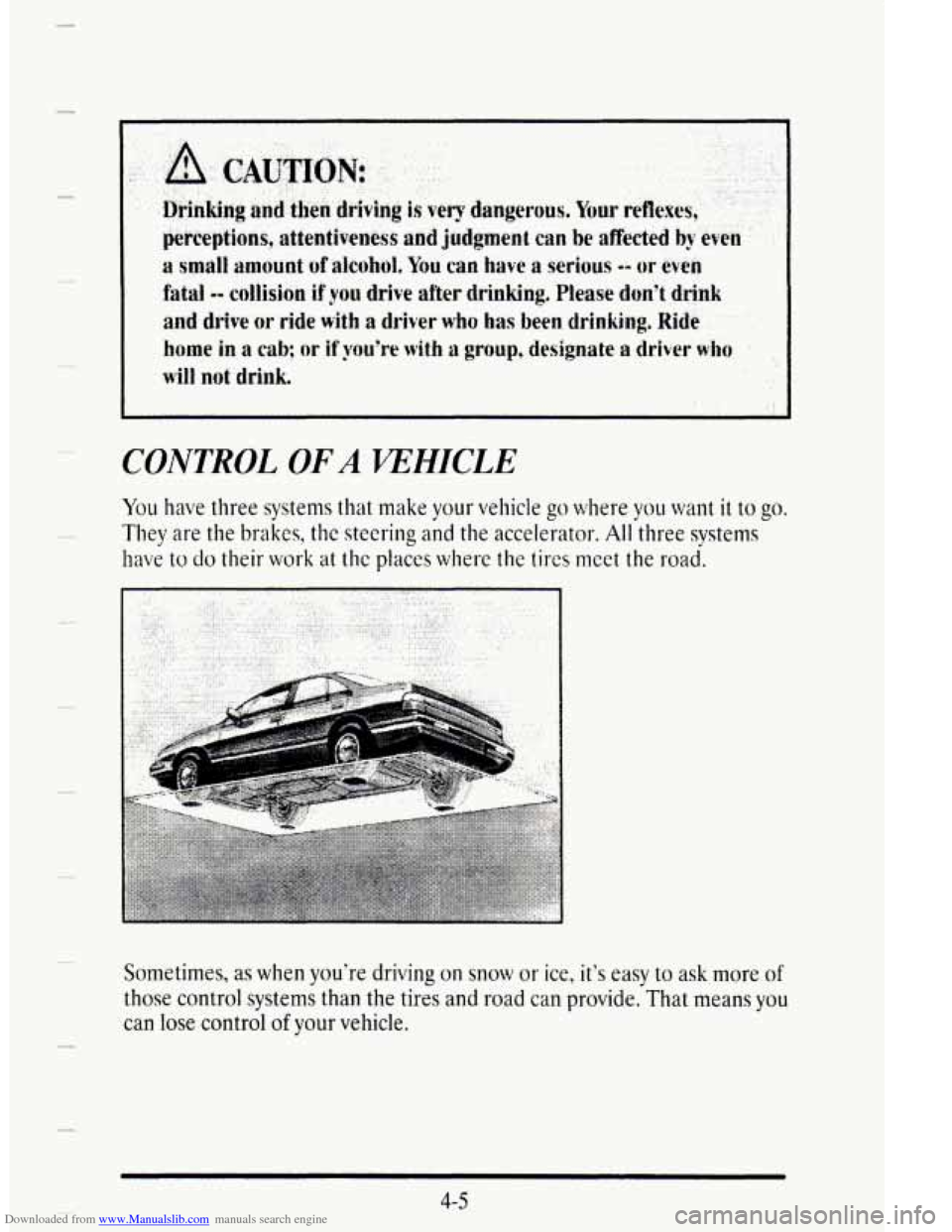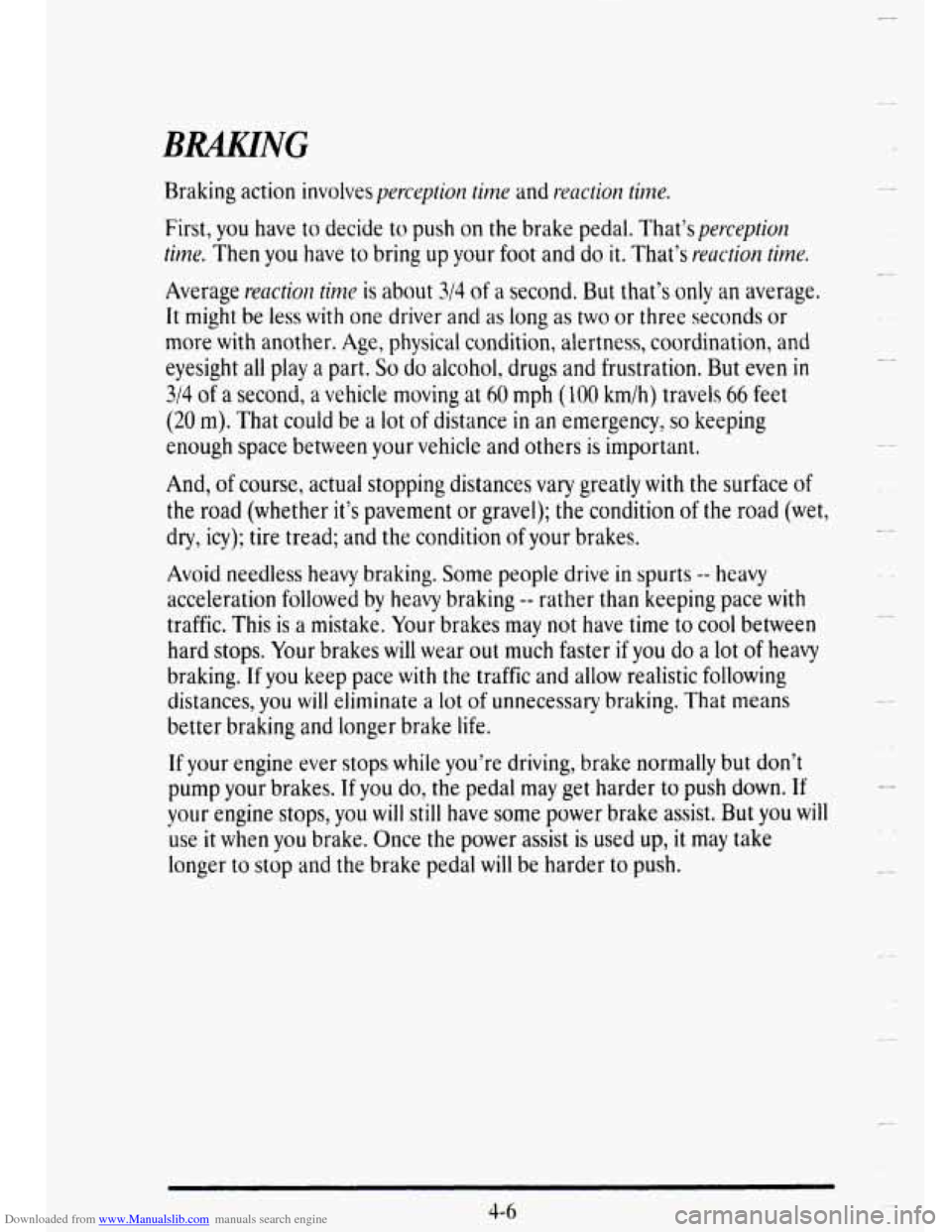1995 CADILLAC DEVILLE brake
[x] Cancel search: brakePage 150 of 403

Downloaded from www.Manualslib.com manuals search engine c
Brake System Warning Light
(0) BRAKE
Your Cadillac's
hydraulic brake system
is divided into two
parts. If one part isn't
working,
L- the other part
can
still work and stop
you. For good braking,
though, V~LI med both
parts wo"rking well.
If the warning light comes on, there could be a brake problem. Have your
brake svstem inspected right away.
This light should come
on brieflv as vou start the vehicle. if it doesn't
come
on then, have it fixed so i
If the light comes on while you are driving, pull off the road and stop
carefullv. You may notice that the pedal is harder to push. Or, the pedal may
go closir to the floor. It may take longer to stop. If the light is still on, have
the vehicle
towed for service. (See "Towing Your Vehicle" in the Index.)
The brake system warning light
will also come on when you set your
parking brake, and it will stay on if your parking brake doesn't release
fully.
If it stays on after your parking brake is fully released, it means you
have
a brake problem.
2-77
Page 151 of 403

Downloaded from www.Manualslib.com manuals search engine Anti-Lock Brake System Warning Light
With the anti-lock brake system, this light will come on when you start
your engine and may stay on for several seconds. That‘s normal. If the
light doesn’t come on, hiwe it fixed so it will be ready to war11 you if there
is a problcm.
If the light stays on, turn the ignition off. Or, if’ the light comes on when
you’re driving, stop as soon as possible and turn the ignition off. Then
start the engine again
to reset the system. If the light still stays on, or
comes on again while you’re driving. your Cadillac needs setvicc. If the
regular brake system warning light isn’t on, vou still have brakes. but you
don‘t have anti-lock brakes. If the regular biake systm warning light is
also on,
you don’t have anti-lock brakes and thcrc’s a problem with yo~u
regular brakes. See “Brake System Warning Light” earlier in this part.
Traction Disabled Message
If this message is displayed. there‘s a problem with vo~~r traction control
system and your vehiclc needs service. When this message is displayed,
the system will not limit wheel spin. Adjust your driving accordingly.
2-7s
u
Page 160 of 403

Downloaded from www.Manualslib.com manuals search engine Driver Information Center Messages
These messages will appear if there is a problem sensed in one of your
vehicle's svstems. Vehicles that arc first sold in Canada will have awnumber
after eachmessage. This number helps
to identify the message, which is
only displayed in English. c
APPLY BRAKE TO SHIFT - 46
This message will appear if your vehicle is in PARK (P) for about 15 seconds
and
the brake is not depressed. If VOLI do not want this message to appear,
you can cancel it by holding the OkF and the blue (cooler) button on the
Electronic Climate Control panel for about five seconds.
Hold the same two
buttons again to have this message displayed.
A/C OVERHEATED - A/C COMPRESSOR OFF - 15
If the refrigerant system ever reaches an over-yrcssure condition, this
message will appear to tell you that the air conditioning compressor has
been turned off. Air conditioned air will not be delivered to cool your
vehicle.
If the pressure returns to a normal operating range, vou must
message co11tinues
to appear, have the system repaired as soon as possible
to avoid compressor damage.
select
AUTO, DEFOG, 01- DEFROST to start the
compress& If this
BATTERY NO CHARGE - 07
This message will appear if your battery is not being charged. Have your
electrical system checlwJ by y~lr Cadi1l;lc dealership at your earliest
conxnience.
BATTERY VOLI'S HIGH - OS
This message shows that the electrical charging system is overcharging,
(more
than I6 volts). To avoid being stranded have the electrical system
checked
by your Cadillac dealership. You can reduce the charging
0verlo;d
by using the accessories. Turn on the lamps and radio, set the
climate cohtrol
on AUTO and the fan spced 011 HI, and turn the rear
window defogger on. You can monitor battery
voltage on the Driver
Information Center
by toggling the INFORMATION button. The normal
range is
11.5 to 15.5 volts when the engine is running.
2-87
Page 161 of 403

Downloaded from www.Manualslib.com manuals search engine BATTERY VOLTS LOW - 06
This message will appear when the electrical system is charging less than
10 volts or if the battery has been drained. If this message appears
immediately after starting,
it is possible that the generator can still
recharge the battery. The battery should recharge after driving a few miles
and the message should go out.
If this message appears while driving or
after starting your vehicle and stays on, have it checked immediately to
determine the
cause of this problem. To help the generator recharge the
battery quicklv
you can reduce the load on the electrical svstem by turning
off your accesbries. You can monitor batten voltage on (he Drivkr
Information Center by toggling the INFORMATION button. The
normal
range is 11.5 to 15.5 volts.
CHANGE TRANS FLUID - 47
This message will appear when it is time to replace the transaxle fluid. See
your maintenance schedule booklet for the proper fluid and change
intervals.
CHECK BRAKE FLUID - 37
This message is displayed to inform the driver that the brake reservoir
fluid level is low. Check the brake reservoir level and add as needed. Have
the brake system serviced
by a Cadillac technician as soon as possible. If
the brake warning light is on, follow the directions in that section.
CHECK COOLANT LEVEL - 04
This message will appear when there is a low level of engine coolant.
Have the
cooling system serviced by a Cadillac technician as soon as
possible.
CHECK FUEL GAGE - 39
This message will appear when your fuel supply is less than four gallons
and your display
is turned off.
2-88
c
Page 195 of 403

Downloaded from www.Manualslib.com manuals search engine Assume that pedestrians or other drivers arc going to be careless and
make mistakes. Anticipate what
they might do. Be ready for their
mistakes.
Rear-end collisions
are about the most preventable of accidents. Yet they
are common. Allow cnough following distance. It's
the best defensive
driving maneuver,
in both city and rural driving. You never know when
the
vehicle in front of you is going to brake or turn suddenly.
DRUNKEN DRIWNG
Death and injury associated with drinking and driving is a national
tragedy.
It's the numbcr one contributor to the highway death toll,
claiming thousands
of victims every year.
Alcohol affects four things that anyone needs to drive
a vehicle:
Judgment
0 Muscular Coordination
0 Vision
Attentiveness
Police records show that almost
half of all motor vehicle-rclated dcaths
involve alcohol. In most
cases. these deaths are the result of somonc who
was drinking and driving. In recent years, sum(: 18.000 annual motor
vehiclerelated deaths have been associated
with the L~SC of ;11cohol, with
more than 300,000 people injurcd.
Many
ad~~lts -- by some cstimatcs, ncarly half the dult
population -- choose never to drink alcohol, so they ncver drive
after drinking. For persons under 21, it's against the law in every U.S.
state to drink alcohol. There are good medical, psychological and
developmental reasons for these laws.
The obvious way to solve this highway safety problem is for people never
to drink alcohol and then drive. But what if people do? How much is "too
much'' if the driver plans to drive? It's a lot less than many might think.
Although it depends on each person and situation. here is some general
information
on the problem.
c
Page 198 of 403

Downloaded from www.Manualslib.com manuals search engine CONTROL OF A WHICLE
You have three systenx that make your vehicle go where you want it to go.
They are the brakes, thc steering and the accelerator. All three systems
have to do their work at thc places where the tires meet the road.
Sometimes, as when you're driving
on snow or ice, it's easy to ask more of
those control systems than the tires and road can provide. That means you
can
lose control of your vehicle.
4-5
Page 199 of 403

Downloaded from www.Manualslib.com manuals search engine Braking action involves yereeption time and recrction time.
First, you have, to decide to push on the brake pedal. That’sperceptioll
time. Then you have to bring up your foot and do it. That’s rerrction time.
Average rerzcfiorz
the is about 3/4 of a second. But that’s only an average.
It might be less with one driver and as long as two or three seconds or
more with another.
Age, physical condition, alertness, coordination, and
eyesight all play a part. So do alcohol, drugs and frustration. But even in
34 of a second, a vehicle moving at 60 mph (100 km/h) travels 66 feet
(20 m). That could be a lot of distance in an emergency, so keeping
enough space between
your vehicle and others is important.
And, of course, actual stopping distances vary greatly with the surface of
the road (whether it’s pavement or gravel); the condition of the road (wet,
dry, icy); tire tread;
and the condition of your brakes.
Avoid needless heavy braking. Some people drive in spurts
-- heavy
acceleration followed by heavy braking
-- rather than keeping pace with
traffic. This is a mistake. Your brakes may not have time to cool between
hard stops. Your brakes
will wear out much faster if you do a lot of heavy
braking.
If you keep pace with the traffic and allow realistic following
distances, you
will eliminate a lot of unnecessary braking. That means
better braking and longer brake life.
If your engine ever stops while you’re driving, brake normally but don’t
pump your brakes. If you do, the pedal may get harder to push down. If
your engine stops, you will still have some power brake assist. But you will
use it when you brake. Once the power assist is used up, it may take
longer
to stop and the brake pedal will be harder to push.
4-6
c-
Page 200 of 403

Downloaded from www.Manualslib.com manuals search engine 4nti-Lock Brakes (ABS)
Your Cadillac has an advanced electronic braking system that will help
)revent a braking skid.
This light on the
instrunlent panel will
come on briefiy when
you start your vehicle.
LOCK (!I
ANTI-
When you start your vshiclc and begin to drive away, you may hear a
momentaw motor or cliclcing noise. And you may even notic; that your
brake pedal nloves a little while this is going on. This is the ABS system
testing itself. If there‘s a problem with the anti-lock brake system, the
anti-lock brake
system warning light will stay on.
See “Anti-Lock Brake System Warning Light” in the Index.
Here’s
how anti-lock works. Let‘s say the road is wet. You’re driving
safely. Suddenly an animal jumps out in front of you.
4-7